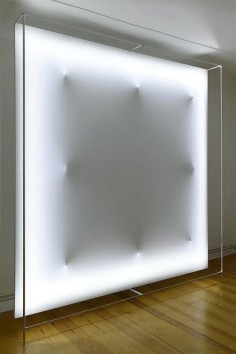ANDREAS LUTZ
FILE SAO PAULO 2017
HYPERGRADIENT

source: fleorgbr
Abstract:
“Hypergradient” (Hipergradiente) analisa as diferentes interpretações de uma declaração imparcial e consistente. A instalação muda repetidamente entre dois estados: o estado de “declaração” e o estado de “interpretação”.
O estado de declaração exibe uma sequência de caracteres de um sistema semiótico distinto, que pode ser descrito como um substituto para todos os sistemas semióticos conhecidos. Esses caracteres individuais são agrupados em linhas e, em seguida, formam ordens de sequência em uma proposição abstrata. Essas proposições abstratas não seguem os princípios humanos habitados, elas possuem lógica inerente e só podem ser decodificadas quando o observador as transfere para sua própria mentalidade. Neste estado, o espaço que contém a instalação e a própria instalação são iluminados com fontes luminosas fixas.
Quando a instalação chega ao estado de interpretação, todo o espaço muda para a escuridão e a superfície é iluminada por quatro fontes de luz dispostas ao redor da instalação. Derivadas das várias visões, compreensões e pré-aprendizagens de um destinatário universal, a sequência e o brilho das fontes de luz seguem seus próprios princípios. Simultaneamente, a sequência dos caracteres permanece a mesma que no estado “declaração”, mas não pode mais ser percebida como caracteres puros. Através da mudança constante da luz, da deformação física da superfície e da consequente modificação da percepção, a declaração original agora precisa ser interpretada pelo observador.
Biografia:
A obra de Andreas Lutz (*1981 em Freiburg, Alemanha) analisa e revela fenômenos de percepção versus realidade, princípios de estética abstrata, bem como a relação entre semiótica e som.
Entre outros, ela foi exposta na 57ª Bienal de Veneza / Pavilhão Antártico em Veneza (Itália), no Centro de Arte e Mídia (ZKM) em Karlsruhe (Alemanha), no Centro Nacional de Arte de Tóquio (Japão), na Galerie Mazzoli, em Berlim (Alemanha), na Bienal de OpenArt em Örebro (Suécia), e ganhou o Prêmio de Excelência no 19º Festival de Mídia e Artes do Japão.
.
.
.
.
.
.
.
source: fileorgbr
Abstract:
“Hypergradient” analyzes the different interpretations of an impartial consistent statement. The installation repeatedly changes between two states: the “statement” state and the “interpretation” state.
The statement state displays a sequence of characters of a distinct semiotic system, which can be described as a deputy for all known semiotic systems. These single characters are grouped to strings and then form string orders into an abstract proposition. These abstract propositions don’t follow human dwelled principles, they possess inherent logic and can only be decoded when the observer transfers them into his own mindset. In this state, the space containing the installation and the installation itself is lit up with fixed light sources.
When the installation reaches the interpretation state, the whole space changes into darkness and the surface is illuminated by four light sources, which are arranged around the installation. Vicarious for the various views, understandings and pre-learnings of a universal recipient, the sequence and the brightness of the light sources follow their own principles. Simultaneously, the sequence of the characters remains the same as in the “statement” state, but cannot perceived as pure characters anymore. Through the constant change of light, the physical deformation of the surface and the consequent modification of perception, the original statement now has to be interpreted by the observer.
Biography:
Andreas Lutz’s (*1981 in Freiburg, Germany) work analyzes and reveals phenomenon of perception versus reality, principles of abstract aesthetics as well as the relation of semiotics and sound.
Among others, Lutz’s work has been exhibited at the 57th Venice Biennale / Antarctic Pavilion in Venice (Italy), in the Center for Art and Media (ZKM) in Karlsruhe (Germany), the National Art Center Tokyo (Japan), Galerie Mazzoli in Berlin (Germany), the OpenArt Biennale in Örebro (Sweden) and won the Excellence Award at the 19th Japan Media and Arts Festival.

